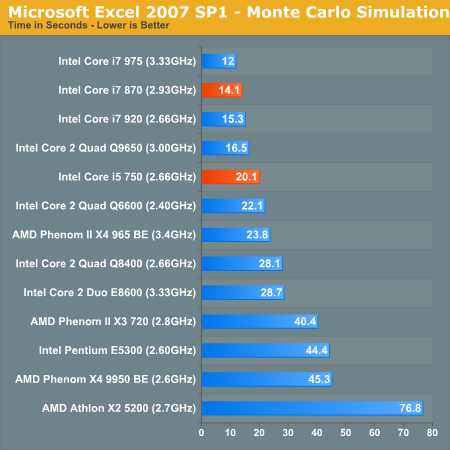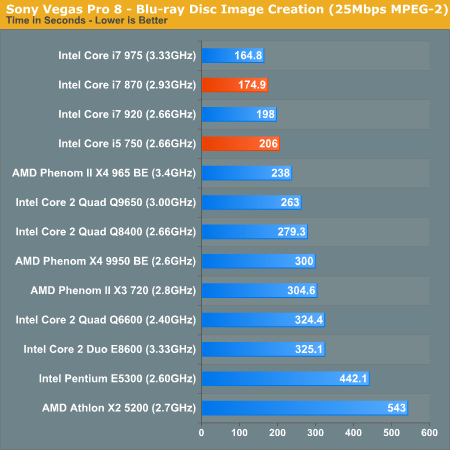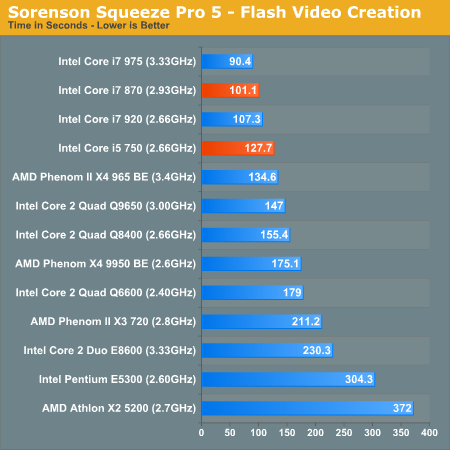Intel's Core i7 870 & i5 750, Lynnfield: Harder, Better, Faster Stronger
by Anand Lal Shimpi on September 8, 2009 12:00 AM EST- Posted in
- CPUs
Microsoft Excel 2007
Excel can be a very powerful mathematical tool. In this benchmark we're running a Monte Carlo simulation on a very large spreadsheet of stock pricing data.

The Excel test is peculiar in its results. It must be one of the few situations where Bloomfield's memory bandwidth advantage is seen as even the Core i7 870 can't outperform the i7 920. The Core 2 Quad Q9650 does well thanks to its large 12MB L2 cache, as does the Q6600 with a beefy 8MB cache.
Sony Vegas Pro 8: Blu-ray Disc Creation
Although technically a test simulating the creation of a Blu-ray disc, the majority of the time in our Sony Vegas Pro benchmark is spend encoding the 25Mbps MPEG-2 video stream and not actually creating the Blu-ray disc itself.

Hyper Threading is good for about 4% here, giving the 920 the slight edge over the Core i5 750.
Sorenson Squeeze: FLV Creation
Another video related benchmark, we're using Sorenson Squeeze to convert regular videos into Flash videos for use on websites.

The i5 750 pays the HT penalty, taking another 20 seconds to render our test video than the i7 920. It is still faster than the Phenom II X4 965 BE at a much lower cost. The Core i7 870 comes close but can't beat the i7 975.










343 Comments
View All Comments
Gary Key - Wednesday, September 9, 2009 - link
Actually the manufacturers wanted Clarkdale desperately for the school/holiday shopping seasons. It is delayed as they are still debugging the platform, unofficially I think that means the drivers are not ready. ;) Believe me, if we had a stable Clarkdale platform worthy of a preview, you would have read about it already.justme2009 - Wednesday, September 9, 2009 - link
You are incorrect sir. The manufacturers were complaining to Intel that they couldn't get rid of the current stock before Intel released mobile Nehalem, so Intel caved.http://techreport.com/discussions.x/16152">http://techreport.com/discussions.x/16152
http://www.techspot.com/news/33065-notebook-vendor...">http://www.techspot.com/news/33065-note...-pushing...
http://www.brighthub.com/computing/hardware/articl...">http://www.brighthub.com/computing/hardware/articl...
http://gizmodo.com/5123632/notebook-makers-want-in...">http://gizmodo.com/5123632/notebook-mak...o-delay-...
Needless to say, I'm waiting for mobile Nehalem (clarkdale/arrendale). With a 32nm manufacturing process, plus starting in 2010, Intel will begin to move both the northbridge and southbridge chips onto the processor die. The move should complete some time around 2011 as far as I can tell.
It will be far better than what we have today, and I'm really ticked off at the manufacturers for holding back progress because of their profit margin.
Gary Key - Wednesday, September 9, 2009 - link
I spoke directly with the manufacturers, not unnamed sources. The story is quite different than the rumors that were posted. I will leave it at that until we product for review.justme2009 - Wednesday, September 9, 2009 - link
Of course the manufacturers wouldn't fess up to it. It's bad business, and it makes them look bad. It already angered a great many people. I don't think they are rumors at all.justme2009 - Wednesday, September 9, 2009 - link
Personally I'm holding off on buying a new system until the northbridge/southbridge migration to the processor die is complete, ~2 years from now. That will definitely be the time to buy a new system.ClagMaster - Tuesday, September 8, 2009 - link
“These things are fast and smart with power. Just wait until Nehalem goes below 65W...”I surely will Mr Shimpi with this exceptional processor. I am going to wait until the summer of 2010 when prices are the lowest, rebates are the sweetest, before I buy my i7 860. By that time, hopefully, there would be 65W versions available on improved stepping. It’s worth the wait.
I would wager the on-chip PCIe controller could use some additional optimization which would result in lower power draw for a given frequency.
Intel sure delivered the goods with Lynnfield.
cosminliteanu - Tuesday, September 8, 2009 - link
Well done Anandtech for this article... :)ereavis - Tuesday, September 8, 2009 - link
great article. Good replies to all the bashing, most seem to have misread.Now, we want to see results in AnandTech Bench!
MODEL3 - Tuesday, September 8, 2009 - link
Wow, the i5 750 is even better than what i was expecting...For the vast, vast majority of the consumers, (not enthusiasts, overclocking guys, etc...) with this processor Intel effectively erased the above 200$ CPU market...
I hope this move to have the effect to kill their ASP also... (except AMDs...) (not that this will hurt Intel much with so many cash, but it is better than nothing...)
I see that the structure/composition in this review and in many others tech sites reviews is very good, maybe this time Intel helped more in relation with the past regarding info / photos / diagrams / review guide etc...
One question that i have (out of the conspiracy book again...) is,
if the integration of the PCI-Express controller in the CPU die on the mainstream LGA-1156 platform will be a permanent strategy from now on...
and if the recent delay for the PCI-Express standard 3.0 has a connection with the timing of the launch of mainstream LGA-1156 based CPUs with PCI-Express 3.0 controller integrated...
Sure, they can launch future LGA-1156 motherboard chipsets with PCI-Express 3.0 controller, but doesn't this contradict the integration strategy that Intel just started with the new processors?
MODEL3 - Tuesday, September 8, 2009 - link
I can't edit...I just want to clarify that the PCI-Express 3.0 question is for LOL reasons, not taken serious...